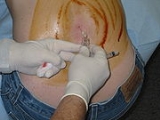
Lumbar puncture
Overview
A lumbar puncture is a diagnostic
and at times therapeutic procedure that is performed in order to collect a sample of cerebrospinal fluid
(CSF) for biochemical
, microbiological
, and cytological
analysis, or very rarely as a treatment ("therapeutic lumbar puncture") to relieve increased intracranial pressure.
The most common purpose for a lumbar puncture is to collect cerebrospinal fluid
in a case of suspected meningitis
, since there is no other reliable tool with which meningitis, a life-threatening but highly treatable condition, can be excluded.
Medical diagnosis
Medical diagnosis refers both to the process of attempting to determine or identify a possible disease or disorder , and to the opinion reached by this process...
and at times therapeutic procedure that is performed in order to collect a sample of cerebrospinal fluid
Cerebrospinal fluid
Cerebrospinal fluid , Liquor cerebrospinalis, is a clear, colorless, bodily fluid, that occupies the subarachnoid space and the ventricular system around and inside the brain and spinal cord...
(CSF) for biochemical
Biochemistry
Biochemistry, sometimes called biological chemistry, is the study of chemical processes in living organisms, including, but not limited to, living matter. Biochemistry governs all living organisms and living processes...
, microbiological
Microbiology
Microbiology is the study of microorganisms, which are defined as any microscopic organism that comprises either a single cell , cell clusters or no cell at all . This includes eukaryotes, such as fungi and protists, and prokaryotes...
, and cytological
Cytopathology
Cytopathology is a branch of pathology that studies and diagnoses diseases on the cellular level. The discipline was founded by Rudolf Virchow in 1858. A common application of cytopathology is the Pap smear, used as a screening tool, to detect precancerous cervical lesions and prevent cervical...
analysis, or very rarely as a treatment ("therapeutic lumbar puncture") to relieve increased intracranial pressure.
The most common purpose for a lumbar puncture is to collect cerebrospinal fluid
Cerebrospinal fluid
Cerebrospinal fluid , Liquor cerebrospinalis, is a clear, colorless, bodily fluid, that occupies the subarachnoid space and the ventricular system around and inside the brain and spinal cord...
in a case of suspected meningitis
Meningitis
Meningitis is inflammation of the protective membranes covering the brain and spinal cord, known collectively as the meninges. The inflammation may be caused by infection with viruses, bacteria, or other microorganisms, and less commonly by certain drugs...
, since there is no other reliable tool with which meningitis, a life-threatening but highly treatable condition, can be excluded.

